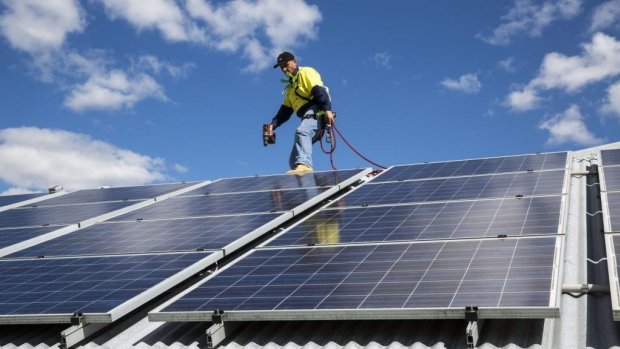An article in today's AFR confirms that power pricing is slowly heading down and it is possible will reach the target price range set out by Energy Minister Angus Taylor.
*******************************************************************************************
Record low demand for grid power strains system Angela Macdonald-Smith
Angela Macdonald-SmithSenior Resources Writer
Feb 17, 2020 — 12.00am
Solar-rich South Australia has set a new record low for electricity demand from the grid but the renewables-dominated state still had the highest average prices in the December quarter as it struggled to meet soaring demand as summer weather took hold.
Wholesale power prices in all regions of the National Electricity Market were between 10 and 20 per cent lower in the December quarter than the year-earlier period, falling below $90 a megawatt-hour for the first time since late 2017, according to an Australian Energy Regulator report to be released on Monday.
Despite frequent spikes in prices to extreme levels as bushfires hit the grid in January, prices in all states of the NEM are tracking towards
Federal Energy Minister Angus Taylor's target to fall below $70 by the end of 2021.

The unstoppable rise of rooftop solar is contributing to huge volatility in demand for grid-based power. Glenn Hunt
The AER's new chair Clare Savage said the lower rates were "good to see after a period of sustained high prices".
But the huge influx of rooftop solar is contributing to record low demand for grid-based power during the daytime - most obvious in South Australia - and leading to huge swings in consumption and prices.
South Australia saw a new all-time low demand for grid-based power of 456MW just after midday on November 10 as rooftop solar met a chunk of requirements, often
pushing wholesale prices below zero. Six other days that quarter also saw demand lower than the previous record of 580MW set three years earlier.
The AER said installation rates of rooftop solar doubled between 2015 and 2018, while the average capacity is also increasing, helping gouge out demand for grid-based power during the day, a phenomenon known as the "duck curve".
Minimum demand as a result mostly occurs in daytime rather than overnight, typically between 11:30am and 2:30pm. But rooftop solar has little impact on peak demand, between 6:30pm and 7:30pm, when panels are producing very little.
That leads to a widening gap between minimum and maximum demand, putting the pressure on generation from other sources to meet consumption needs, even if they lie idle earlier in the day.
"This is posing a number of challenges for AEMO and participants
leading to a change in how traditional baseload units are operated," AEMO noted.
"Older gas and coal units do not have the flexibility to turn off during the day when demands are low and return for the evening peak."
The increasingly volatile demand contributed to South Australia's last baseload coal plant closing in 2018 and is now putting pressure on older coal generators in Victoria and elsewhere.
Across the NEM, the AER investigated instances of prices spiking above $5000/MWh later in the December quarter as extreme heat spread across the south-east but found no evidence of anticompetitive behaviour by generators.
The last few months of 2019 were coloured by
worries about potential summer blackouts due to a shortfall in generation amid unexpected and lengthy outages at AGL Energy's Loy Yang A coal power station and Origin Energy's Mortlake gas plant in Victoria.
But Ms Savage said the AER found the NEM "coped well" under the pressure of hot temperatures and outages.
Mortlake came back online before the summer hit, while Unit 2 at Loy Yang A followed later after hiccups in recommissioning.
“Generator outages were progressively resolved, meaning there were no actual reserve shortfalls in the quarter and reserve contracts were only dispatched once,” she said.
The reserve contracts - triggered when the Australian Energy Market Operator identifies a shortage of generation that could lead to blackouts - were however
called upon several times in January amid the bushfires and an extended wave of heat and humidity.
JPMorgan analyst Mark Busuttil said the trend of significant spot and forward price declines continued into January, thanks to lower demand, good baseload generation and lower gas prices.
But he said prices appear to have "found a floor" since mid-January and that higher prices would be needed to drive investment in new plants.
"In our view, current wholesale electricity prices and gas prices are too low to incentivise new capacity growth and therefore are unsustainable over the medium term," Mr Busuttil said.
AGL Energy chief executive Brett Redman said last week he expects prices to trade in the $60 to $90 a megawatt-hour range over the next few years.
Mr Redman said that while prices could remain volatile this March quarter, "the long term trajectory remains for prices to continue to trend down as more supply comes on and demand remains flat".
In the December quarter, wholesale prices were lowest in Queensland at $65/MWh, up to South Australia with $87/MWh.